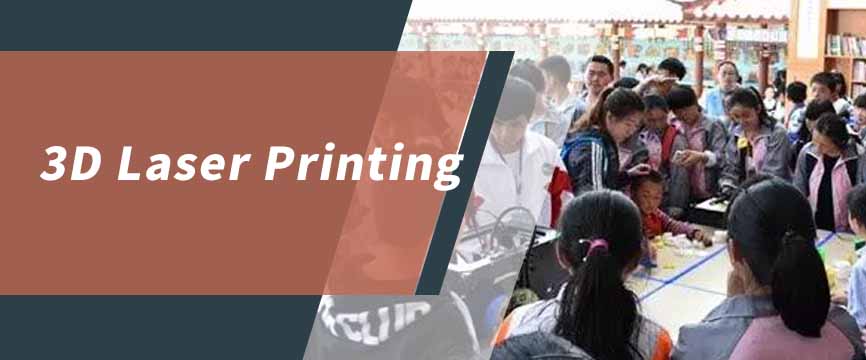Environmental protection, zero inventory, and innovation are the keywords of the 3D printing machine in terms of its advantages. The main focus is materials involved in the use of 3D laser printing machines. Either plastic materials or metal and its composite materials can be processed and the 3D laser printer is also able to make the most of the unique properties of different materials to achieve high-quality printing results. Custom processing is possible, ranging from printing pills to printing food. Not only can objects be printed but intended functions can also be embedded in them. The equipment has been widely applied in the manufacturing industry and applying it to the education field will be a trend to play an assistance part in it and make students more well-rounded.
It is known that the reason why students fail to perform well in traditional education is that they are not interested in courses that are highly theoretical. Although they can pass the exams by rote memorization of abstract concepts, relevant knowledge will be quickly forgotten after the exams. In contrast, using 3D printers makes abstract course contents more concrete and the visual and tactile learning methods make the boring courses vivid and attractive as well. Meanwhile, in tactile learning, students can learn with the auxiliary models made by 3D laser printers to understand related concepts rather than simply looking at text or graphics on a board or monitor. This teaching approach with 3D models makes it easier for students to acquire new knowledge and master it for a longer time.

More and more schools have been exploring the use of 3D laser printing machines in education, and relevant applications have been becoming more diverse. Not only can teachers use 3D laser printing models to teach, but they can also use related technology to enhance students’ creativity, enabling them to quickly verify design concepts as well as make and modify models.
In math classes, printing out a model of a geometry helps students understand the connection between the elements within the geometry in a more visual way; in art classes, it is possible to use 3D laser printing machines to make graphic works into 3D versions of artwork or some basic models; in chemistry classes, teachers can print out molecular models for display, which can help students gain a deep insight into the process of chemical reactions; in biology classes, cells, viruses, organs, and other important biological samples can be printed out to provide more visual demonstration than 2D graphs; in geography classes, 3D models of how topography, landforms, and climate form is more vivid than explanations in words.
In professional fields, including architecture, medicine, biology, automotive engineering, painting, and historical archaeology, innovative learners can use 3D laser printers as a means of their studying and verification of assignment designs. It is also possible for students majoring in mechanical or industrial design to apply 3D laser printing machines to create prototypes of products so they may assess their work in 3D.
The use of 3D laser printing machines in classes provides students with a vivid DIY and three-dimensional learning approach, allowing them to gain a more realistic and concrete experience of subjects. This application enables students to take part in all aspects of teaching and learning as well as improves their practical skills and their class participation. Meanwhile, their studying motivation can be stimulated and their creativity and innovation also fostered while teachers are able to impart knowledge in multiple ways via the use of 3D laser printing machines.

For introductory 3D printing education, the focus is not on the 3D printing technology itself, but on how to model and design. 3D printing technology has become a vehicle for the stimulation of learners’ creativity and imagination. Cells, organs, or any personalized models or devices can be printed by 3D laser printers. 3D printed models can be used to provide a visual presentation of esoteric concepts in chemistry, physics, biology, and mathematics to gain a better understanding. It can also serve as a means to complete coursework, including testing prototypes and presenting engineering solutions. In addition, 3D printing technology can be used to inspire students to create aesthetically and creatively, such as the creation of different textures and complex geometric structures.
By comparison, higher education focuses on how to use and develop industrial 3D printing technology, how to reach the potential of 3D printing technology in aerospace, automotive, life sciences, and other fields, how to use software to control the process and results of 3D laser printing machines and achieve the expected quality, as well as how to change parameters in the 3D printing process to improve the process of printing.
Countries all over the world have been carrying out R&D and market development of 3D laser printing machines. With the advent of the 3D printing era, various industries will face huge changes, including the education industry. It is foreseeable that with the guidance of the government and the growing interests of corporations in 3D printing, the cost of raw materials will fall, while 3D laser printers will continue to develop and become more cost-effective as well as go mainstream in the education sector.
Media Contact
Company Name: LASERCHINA
Contact Person: Kevin
Email: Send Email
Phone: 86-10-64426993
Address:#22 Building, #13 Mintai Road Shunyi District
City: Beijing,101300
Country: China
Website: https://www.laserchina.com/

